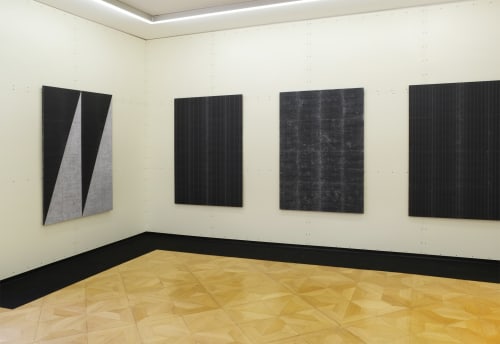Mathias Pöschl, who was born in Vienna in 1981, studied at the Academy of Fine Arts Vienna under Gunter Damisch. Since graduating in 2008, he has exhibited at venues including 21er Haus, Georg Kargl Fine Arts and the Neuer Wiener Kunstverein, as well as in various Viennese off-spaces. Mathias Pöschl showed one of his most extensive works to date at the Leopold Museum in 2016 as part of the ‘Poetics of Material’ exhibition: a large-scale installation in which he utilised the cultural connotations of various materials to combine them with a shadowy formal language of stage sets.
In his exhibition ‘07/05 - 22/06/19’ at the bechter kastowsky gallery, Mathias Pöschl is showing his latest series of black and white panel paintings. The main part of the exhibition consists of large and medium-format pictures covered with a thin layer of photocopy paper. The works show grids composed of several photocopies. One black copy has been folded, causing it to lose pigment at the fold. At this point, the white paper shines through and forms a light-coloured line that contrasts with the noisy, almost black surface. Copies of this fold cover its base, a sheet of chipboard, in a serial arrangement. The rhythm of fold and seam between the individual sheets creates a grid - it is created in the material and allows figure and ground to merge.
The grid, which was played out in various works in the 20th century, especially in Minimal Art, as an ineluctable zero point and expression of non-hierarchical abstraction, e.g. in the work of Piet Mondrian, Agnes Martin, Frank Stella or Donald Judd, refers to a stable origin. Mathias Pöschl, on the other hand, constructs his grids from copies of a copy: a repetition that is neither farce nor comedy, but rather shows a quasi-original excerpt that is always based on just one copy.
The display in his exhibition consists of wall installations that transform the gallery space into an almost closed system, with only one window remaining unobstructed. This prominent opening in the wall suggests a compelling connection between the grids dealt with in the works and the window. Not only does light enter the room through the glass, it also divides the view through the window frame and muntins into a gridded view to the outside, which, when it is dark outside, allows us to be reflected in the grid ourselves.
In her well-known text ‘Grids’ from 1979, Rosalind Krauss mentions with some astonishment that, although the grid is the very variety of materialism, artists were much more inclined to negotiate ontological considerations in their grid images. Mathias Pöschl's exhibition makes it clear that material and order are not factors that can be separated from each other; material is not the carrier of considerations, but contributes to them through its respective properties.


